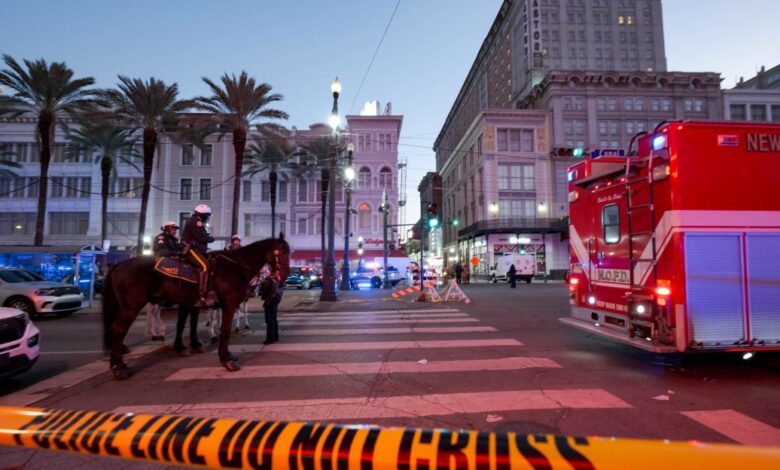New Orleans attack: What does it mean to join ISIS in 2025?

The deadly attack in New Orleans on New Year’s Eve that left 15 people dead feels like a disturbing reminder of a past era, one when the transnational terrorist organization known as the Islamic State, or ISIS, dominated the nation’s attention and resources.
The attacker, Shamsud-Din Bahar Jabbar, a 42-year-old Army veteran from Texas, rammed a truck into Bourbon Street before he was killed in a shootout with police. Jabbar was flying an ISIS flag from his vehicle and posted videos on Facebook shortly before the attack, pledging support to the group.
In a briefing on Thursday, FBI Deputy Assistant Director Christopher Raia described Jabbar as “100 percent inspired by ISIS.” Raia said that Jabbar, who had also planted two explosive devices on Bourbon Street that never went off, claimed he had joined ISIS before last summer. In his videos, Jabbar said he had originally planned to attack his relatives and friends — he had recently gone through a divorce — but worried that media coverage would not focus on what he called the “war between the believers and disbelievers.” Authorities are also investigating whether there is any link between the attack and a truck bombing that took place outside the Trump Hotel in Las Vegas on the same day, though for now there does not appear to be.
Using trucks and vans to ram into crowds has been a staple of deadly ISIS-linked attacks for years, from Nice, France, to Barcelona, to Berlin, to Stockholm. New Orleans is likely the biggest ISIS-inspired attack on US soil since 2016, when gunman Omar Mateen killed 49 people at Pulse, an LGBTQ+ nightclub in Orlando, Florida. The last significant ISIS-inspired attack in the US was in 2017, when Sayfullo Saipov drove a truck onto Manhattan’s West Side Highway, killing eight people.
ISIS-linked violence is still common around the world — there was a major suicide attack on a military base in Somalia just this week. The group’s Afghanistan-based affiliate, ISIS-K, has been particularly ambitious and global in its activities. It carried out an attack on Moscow’s Crocus theater that killed more than 130 people last March, as well as the suicide bombings that killed nearly 100 people in Tehran in January 2024. In August, authorities foiled a “quite advanced” ISIS-K plot to attack a Taylor Swift concert in Austria.
The fact that there hadn’t been any recent ISIS-inspired attacks in the US in recent years may not be from lack of trying. Aaron Y. Zelin, who researches and tracks jihadist groups at the Washington Institute for Near East Policy, notes that there were five arrests for ISIS-related plots in the US in 2024, including attempts to “target churches in Idaho, LGBTQ ‘establishments’ in Philadelphia, Jewish centers/synagogues in New York City, election day voting locations in Oklahoma City, and a Pride parade in Phoenix.” That’s up from zero arrests of this type in 2023.
The fact that one of the group’s self-acknowledged acolytes has now succeeded to deadly and tragic effect raises some tough questions about whether ISIS is primed for a resurgence, and what it actually means to be “ISIS-affiliated” today.
The “caliphate” is down but not out
ISIS traces its origins back to 2011, when fighters from al-Qaeda’s Iraqi affiliate, then led by Abu Bakr al-Baghdadi, traveled to Syria to create a new affiliate there to fight in that country’s civil war. In 2013, al-Baghdadi tried to merge the Iraqi and Syrian affiliates, a move that was rejected by al-Qaeda leaders and led to a major schism in the global jihadi movement.
In 2014, Baghdadi’s group began seizing towns in western Iraq, eventually taking Mosul, Iraq’s second-largest city. At its height in 2014 and 2015, the group controlled an area the size of Great Britain, which Baghdadi declared as a new “caliphate” under his rule. ISIS’s emphasis on controlling territory and imposing its brutal theocratic rule, rather than remaining underground, distinguished it from other militant groups, as did the bloody theatricality of its methods: The group burst into many Americans’ consciousness with the videotaped beheadings of two American journalists.
A US-led military intervention to fight ISIS began in 2014. In 2019, the group’s last territorial outpost in Syria fell to the US-backed Syrian Democratic Forces (SDF). Al-Baghdadi himself was killed in a US raid a few months later. In 2020, President Donald Trump proclaimed in his State of the Union address that “the ISIS territorial caliphate has been 100 percent destroyed.”
This was basically true, but ISIS in a more diffuse form has outlived the territorial caliphate. In Iraq and Syria, it continues to operate underground and carry out attacks, and is regularly targeted in airstrikes and raids by US forces and their local partners.
But in many ways, what was once known as the Islamic State in Iraq and Syria is a more decentralized and global organization today, in which local franchises from Afghanistan, to Somalia, to West Africa, to Mozambique are now often far more active and dangerous than the core group. They also operate more like traditional terrorist organizations than the quasi-nation state that ISIS was at its peak.
ISIS is also still very much a presence online, though somewhat less so than it was at the caliphate era, researchers say. Like other militant groups, it is particularly active on the encrypted messaging app Telegram, as well as the decentralized messaging platform Rocket.Chat. (Other social media platforms are more closely monitored, though the wide spread of footage from the Crocus attack on X suggests the site formerly known as Twitter has become more of a free-for-all in its current incarnation.)
ISIS distinguished itself from al-Qaeda and other groups through its heavy use of English-language propaganda and by encouraging sympathizers to carry out attacks in ISIS’s name. This would appear to be what just happened in New Orleans.
“They put out stuff about doing attacks in English almost every day,” the Washington Institute’s Zelin said.
Lone wolf or part of a pack?
According to the FBI, Jabbar claimed in the videos he posted on the night of the attack that he had joined ISIS before last summer, but the FBI’s Raia also emphasized that based on analysis of Jabbar’s communications and social media accounts, “there is just nothing to indicate … that he was aided in this attack by anyone.” In other words, he acted alone, but also considered himself part of a group.
This is not as much of a contradiction as it might seem. Some of the largest and deadliest ISIS attacks in the West, such as the 2015 massacre of 130 people at several locations in Paris, were coordinated by ISIS itself or carried out by people who had fought and trained with the group in the Middle East.
But this is increasingly rare. As the French counterterrorism analyst Wassim Nasr told Vox in July, “All these things used to be done from ISIS hubs, but ISIS doesn’t have territory anymore. It’s totally dematerialized.” More common are for people who want to carry out attacks to interact only with ISIS “cyber-coaches” who advise them on planning and logistics.
Sometimes, the relationship is even less direct. The Orlando and Manhattan attackers don’t appear to have had any interaction with ISIS abroad. They were “self-radicalized” — inspired by the group’s message and methods to carry out an attack of their own.
That also seems to be the case with Jabbar, based on statements from law enforcement, though it’s still early days. One development that could change our understanding of the attacks is if ISIS were to post a pre-recorded message from Jabbar on its own channels. “That would suggest that this wasn’t just somebody that was only inspired by ISIS, but was likely in contact with ISIS operatives,” Zelin said. (In the case of the Moscow attacks, the ISIS-affiliated Amaq News Agency posted bodycam footage from the attack itself.)
So far, none of ISIS’s official channels have claimed credit for the attack, though there’s a good chance they will. ISIS has never been shy about claiming credit, even for attacks it clearly had nothing to do with.
Colin Clarke, a counterterrorism researcher at the Soufan Center, noted that ISIS-affiliated Telegram and Rocket.Chat channels had been calling for attacks over Christmas and New Year’s. Clarke told Vox that the fact that Jabbar doesn’t appear to be part of an organized underground cell shouldn’t necessarily be comforting.
“To me, the fact that it was a lone actor is more nefarious,” he said. “That’s the ISIS model. They want to be able to reach out and inspire somebody in the US to be able to do this. Their ultimate goal is to make Americans fearful.”
Trump vs. ISIS: The rematch?
There was already renewed global concern about an ISIS resurgence before the New Orleans attack, mainly due to events in the Middle East. As White House national security adviser Jake Sullivan put it, there’s concern that ISIS will “get new oxygen” from the instability in Syria following the overthrow of longtime dictator Bashar al-Assad. (The main group that has taken power in Syria, Hayat Tahrir al-Sham, is itself the successor of the al-Qaeda affiliate that split from ISIS back in 2013, though it has also renounced al-Qaeda and is attempting to present a more moderate face to the world.) The US has been stepping up its strikes against ISIS targets in Syria since Assad’s fall, in an attempt to prevent it from taking advantage.
There’s also concern about the security of the camps in northeast Syria where thousands of ISIS fighters and their families have been detained for years. These camps are under the control the US-backed, predominantly Kurdish SDF, which is currently under threat from the Turkish military and its local proxies.
“ISIS will be a policy question for the [incoming] Trump administration,” said Javed Ali, a longtime FBI terrorism analyst who served on the National Security Council during Trump’s first term. “Despite the fact that ISIS is not the organization it was a decade ago, we do need to take a new look at our counterterrorism approach.”
Though Trump frequently touts the defeat of ISIS’s caliphate among his first-term accomplishments, he has also frequently expressed a desire to scale back US commitments in the Middle East, including removing the troops in Syria currently involved in fighting remnants of ISIS. (For what it’s worth, the president-elect’s first reaction to the attack was to falsely claim that the US-born Jabbar was an immigrant.)
Overall, counterterrorism is far less of a point of emphasis for US national security than it was a decade ago, as attention and resources have shifted to “great power competition” with China and Russia. That’s an understandable and mostly welcome development, but a few more events like what we just saw in New Orleans could change that trend very quickly.
Correction, January 3, 11 am ET: A previous version of this story misstated the size of Mosul. It is Iraq’s second-largest city.
https://platform.vox.com/wp-content/uploads/sites/2/2025/01/gettyimages-2191470553.jpg?quality=90&strip=all&crop=0%2C10.732984293194%2C100%2C78.534031413613&w=1200
2025-01-02 16:15:00




